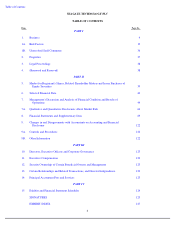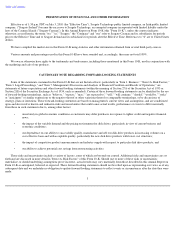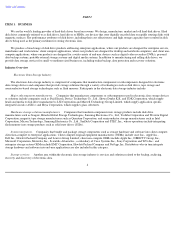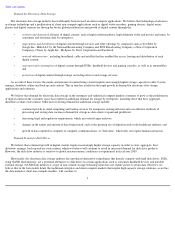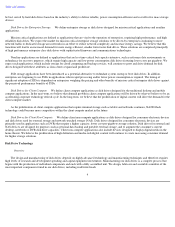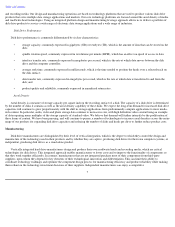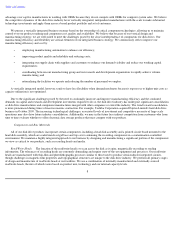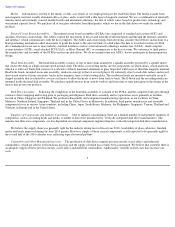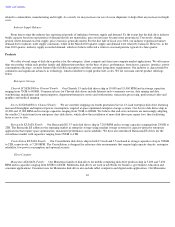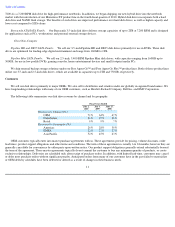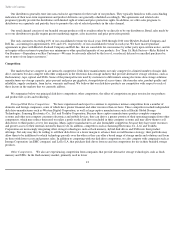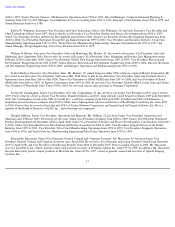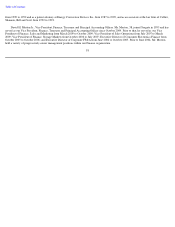Seagate 2009 Annual Report Download - page 14
Download and view the complete annual report
Please find page 14 of the 2009 Seagate annual report below. You can navigate through the pages in the report by either clicking on the pages listed below, or by using the keyword search tool below to find specific information within the annual report.
Table of Contents
Our distributors generally enter into non-exclusive agreements for the resale of our products. They typically furnish us with a non-binding
indication of their near-term requirements and product deliveries are generally scheduled accordingly. The agreements and related sales
programs typically provide the distributors with limited right of return and price protection rights. In addition, we offer sales programs to
distributors on a quarterly and periodic basis to promote the sale of selected products in the sales channel.
Our retail channel consists of our branded storage products sold to retailers either by us directly or by our distributors. Retail sales made by
us or our distributors typically require greater marketing support, sales incentives and price protection periods.
The only customers exceeding 10% of our consolidated revenue for fiscal years 2008 through 2010 were Hewlett-Packard Company and
Dell Inc., accounting for approximately 16% and 11%, respectively, of our consolidated revenue in each year. We have master purchase
agreements in place with Hewlett-
Packard Company and Dell Inc. that are cancelable for convenience by either party upon written notice, and do
not require either customer to purchase any minimum or other specified quantity of our products. See "Item 1A. Risk Factors—Risks Related to
Our Business—Dependence on Key Customers—We may be adversely affected by the loss of, or reduced, delayed or cancelled purchases by,
one or more of our larger customers."
Competition
The markets that we compete in are intensely competitive. Disk drive manufacturers not only compete for a limited number of major disk
drive customers but also compete with other companies in the electronic data storage industry that provide alternative storage solutions, such as
flash memory, tape, optical and SSDs. Some of the principal factors used by customers to differentiate among electronic data storage solutions
manufacturers are storage capacity, price per unit and price per gigabyte, storage/retrieval access times, data transfer rates, product quality and
reliability, supply continuity, form factor, warranty and brand. We believe that our disk drive products are competitive with respect to each of
these factors in the markets that we currently address.
We summarize below our principal disk drive competitors, other competitors, the effect of competition on price erosion for our products
and product life cycles and technology.
Principal Disk Drive Competitors. We have experienced and expect to continue to experience intense competition from a number of
domestic and foreign companies, some of which have greater financial and other resources than we have. These competitors include independent
disk drive manufacturers such as Western Digital Corporation, as well as large captive manufacturers such as Hitachi Global Storage
Technologies, Samsung Electronics Co., Ltd. and Toshiba Corporation. Because these captive manufacturers produce complete computer
systems and other non-
compute consumer electronics and mobile devices, they can derive a greater portion of their operating margins from other
components, which may reduce their need to realize a profit on the disk drives included in their computer systems and may allow them to sell
disk drives to third parties at very low margins. Many captive manufacturers are also formidable competitors because they have more resources
and greater access to their internal customers than we do. In addition, competitors such as Samsung Electronics Co., Ltd. and Toshiba
Corporation are increasingly integrating other storage technologies such as flash memory, hybrid disk drives and SSDs into their product
offerings. Not only may they be willing to sell their disk drives at a lower margin to advance their overall business strategy, their portfolio may
allow them to be indifferent to which technology prevails over the other as they can offer a broad range of storage media and solutions and focus
on those with lowest costs and greatest sales. In addition to competing with our disk drive competitors, we also compete with companies such as
Iomega Corporation (an EMC company) and LaCie S.A. that purchase disk drives from us and our competitors for use in their branded storage
products.
Other Competitors. We also are experiencing competition from companies that provide alternative storage technologies such as flash
memory and SSDs. In the flash memory market, primarily used in lower
12


